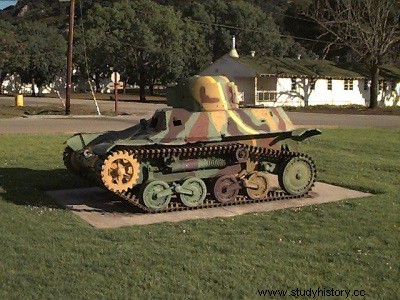
Type: light tank.
Crew: 2 men.
Armament: a 37 mm Type 94 cannon (see text).
Armor: max 12mm.
Dimensions:
length: 3.68 m;
width: 1.80 m;
height: 1.77 m.
Weight in combat order: 4.7 t
Engine: Ikega 4 cyl. in-line air-cooled diesel, developing 66 hp at 2,300 rpm.
Performance:
maximum road speed: 42 km/h;
range: 250 km;
clear cut: 1.70 m;
slope: 60%.
Service time: in the Japanese army from 1938 to 1945.
The Type 97 (or Te-ke/Ke-ke) light tank was created to replace the Type 94 which had proven unsafe in action. The Tokyo Motor Industry (now Hino Motors) built two different prototypes of the Type 97, with the engines supplied by Ikega. These first prototypes were completed in 1937.
In the initial model, the engine and driver were at the front and the turret at the rear, while the engine of the second model was placed at the back to facilitate communications between the driver and the gunner.
After tests, this last model, standardized under the name of light tank Type 97, was introduced into the army in 1938. It was the last light tank to be adopted by the Japanese army, this type of tank being outdated when the outbreak of the second World War. However, it continued to be built long after the war began and in greater numbers than any other Japanese light tank. Its hull had a riveted structure.
The driver was at the front left and the tank commander - who also acted as gunner - was in the turret located in the center of the hull. Engine and transmission were in the back. The suspension consisted of two bogies with two wheels each, the sprocket at the front, the tensioning wheel at the rear and two support rollers. The armament consisted of a 37 mm cannon with a total of 96 shells. On some models, a 7.7mm machine gun replaced the cannon.
There were several variants of the Type 97 light tank, including a model with the turret removed and the engine moved to the front in order to obtain a large rear space for transporting equipment. This model was used for a wide variety of purposes, including as a tanker, as a mobile observation post, as a tethered balloon mooring vehicle and as a self-propelled gun carrying, at the rear of the hull, an anti-tank piece of 37 or 47 mm.
